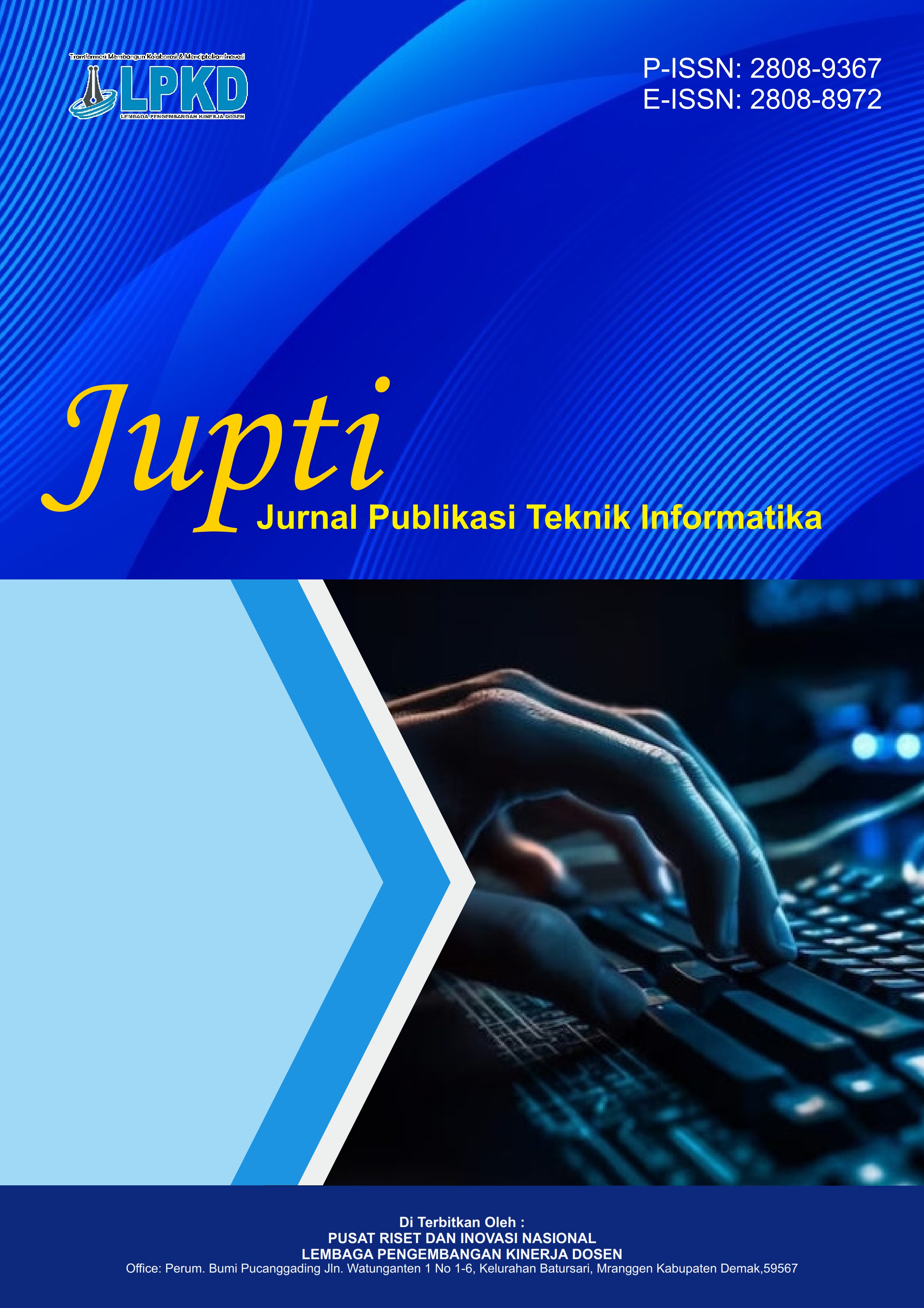Perancangan Sistem Kontrol Kecepatan Kapal dengan Sistem Propulsi Hibrida berbasis Neural Network Method
DOI:
https://doi.org/10.55606/jupti.v4i3.5478Keywords:
BLDC Motor, Hybrid Propulsion, Neural Network, Speed Control, Trimaran ShipAbstract
The increasing number of fossil fuel-powered vessels in Indonesia poses serious challenges related to energy efficiency and exhaust emissions. This study aims to design and implement a hybrid propulsion ship speed control system based on the Neural Network (NN) method to improve fuel efficiency, speed stability, and system safety. The system was developed on a trimaran ship prototype that combines a Brussles Directional Current electric motor and an Internal Combustion Engine (ICE). The Neural Network method is designed with a 5-8-3 architecture as an adaptive controller, processing actual speed and RPM inputs to generate real-time motor control signals. Tests were conducted statically and dynamically at five speed set points under current conditions of ±0.57 m/s and waves of 2–15 cm. The test results showed that the application of Neural Network control improved speed stability, with a deviation of <0.5 km/h at the low set point, and significantly reduced RPM fluctuations. Fuel efficiency also improved, especially at high speeds; the increase in consumption was only ±3.42 ml with control compared to ±43.6 ml without control. In addition, the system is equipped with overcurrent protection that effectively prevents component damage, as proven after initial trial incidents. Overall, the results of this study demonstrate that the integration of Neural Network methods into hybrid propulsion systems has great potential for the development of energy-efficient, stable, and environmentally friendly smart ships.
References
Akbar, D., & Riyadi, S. (2019). Pengaturan kecepatan pada motor brushless DC (BLDC) menggunakan PWM (pulse width modulation). 255–262. https://doi.org/10.5614/sniko.2018.30
Aulia, U. (2022). Pelatihan metodologi penelitian eksperimen bagi mahasiswa tingkat akhir. Genitri: Jurnal Pengabdian Masyarakat Bidang Kesehatan, 1(1), 31–37. https://doi.org/10.36049/genitri.v1i1.54
Azmi, M., Munif, N., Teknik, D., Perkapalan, S., & Kelautan, F. T. (2020). Pengendalian kecepatan sistem propulsi hybrid pada model kapal trimaran berbasis neural network.
Chin, C. S., Tan, Y. J., & Kumar, M. V. (2022). Study of hybrid propulsion systems for lower emissions and fuel saving on merchant ship during voyage. Journal of Marine Science and Engineering, 10(3). https://doi.org/10.3390/jmse10030393
Dharma, A. E., Taufik, A., Studi, P., Mesin, T., ITN, D., Raya, J. L., & Km, K. (2019). Maintenance and repair engine Zenoah G300PUM mesin kapal cepat tak berawak fuel engine remote control, 1–5.
Faiz, A., Kusyanti, A., & Siregar, R. A. (2022). Implementasi pengamanan protokol MAVLink menggunakan algoritma kriptografi Simeck. Jurnal Teknologi Informasi dan Ilmu Komputer e, 6(10), 4678–4685.
Kurniawan, E., Koenhardono, E. S., Kurniawan, A., & Kusuma, I. R. (2024). Literature review of hybrid propulsion system on ship. https://doi.org/10.1109/ICEECIT63698.2024.10859836
Lorenza, B. (2019). Monitoring kecepatan motor BLDC dengan beban rem magnetik, 11.
Muhammad, A. H., Baharuddin, & Hasan, H. (2019). Desain konfigurasi sistem propulsi hybrid terhadap pengurangan konsumsi BBM kapal penangkap ikan 30 GT (Configuration design of a hybrid propulsion system to reduce fuel oil consumption of a 30 GT fishing vessel). Marine Fisheries: Journal of Marine Fisheries Technology and Management, 10(1), 1–9. https://doi.org/10.29244/jmf.10.1.1-9
Pustaka, T. (2014). Analisa eksperimental performansi mesin diesel, 1, 1–10.
Samuel, & Sisworo. (2013). Studi konfigurasi lambung kapal trimaran dengan bantuan computational fluid dynamic (CFD). Kapal, 10(3), 132–137.
Saputra, H., Yuniarsih, N., Abdurrahman, N., Muvariz, M. F., Satoto, S. W., & Arjo, T. R. (2018). Update estimasi emisi gas buang kapal di perairan Batam-Singapore menggunakan data Automatic Identification System (AIS). Inovtek Polbeng, 8(2), 314. https://doi.org/10.35314/ip.v8i2.814
Saputra, M. J., & Suryono, R. R. (2024). Implementasi teknologi irigasi tetes pada tanaman jagung menggunakan sensor soil moisture dan mikrokontroler ESP 32. Malcom: Indonesian Journal of Machine Learning and Computer Science, 5(1), 111–118. https://doi.org/10.57152/malcom.v5i1.1642
Subur, J., & Suryadhi. (2022). Pengaturan kecepatan motor penggerak propeller pada kapal menggunakan metode PID dan MA filter, 4(2), 1–6.
Trihantoro, D. H., Darlis, D., & Putri, H. (2014). Implementasi visible light communication (VLC) untuk pengiriman teks. Seminar Nasional Teknologi Terapan 2014, 1–5.
Utomo, D., Wirawan, G. A., Murtianta, B., Teknik, F., Kristen, U., & Wacana, S. (2024). Akuisisi data state of health dan state of charge sel baterai LiPO, 0–12.
Downloads
Published
How to Cite
Issue
Section
License
Copyright (c) 2025 Jurnal Publikasi Teknik Informatika

This work is licensed under a Creative Commons Attribution-ShareAlike 4.0 International License.








